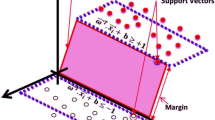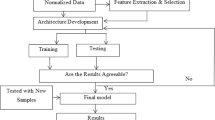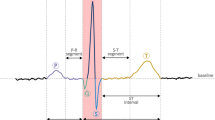Abstract
This study explores the discrimination power of a multiscale analysis method based on the discrete wavelet transform (DWT) in characterizing nonlinear features for congestive heart failure (CHF) recognition. Two DWT paradigms, namely standard DWT and DWT with reconstruction (RDWT), were employed to characterize two categories of nonlinear features, namely sample entropy (SE) and chaotic features, for CHF recognition based on heart rate variability (HRV). The performance of the wavelet-based analysis methods was compared to that of a traditional coarse grained average (CGA) method. The support vector machine was used as a classifier and the capability of the features was evaluated using the leave-one-out cross-validation method. The results show that when using solely SE features, all three multiscale analysis methods (CGA, DWT, and RDWT) with five dyadic scales outperform traditional CGA with twenty consecutive scales in characterizing HRV for CHF recognition. When using chaotic features calculated from the five dyadic scales, RDWT outperformed DWT and CGA with sensitivity, specificity, and accuracy rates of 95.45, 97.22, and 96.55 %, respectively. This performance was even superior to that obtained using both SE and chaotic features. The proposed multiscale analysis method using 5-scale RDWT and chaotic features outperforms three well-known CHF classifiers reported in the literature.



Similar content being viewed by others
References
Malik, M. (1996). Heart rate variability: Standards of measurement, physiological interpretation and clinical use. Circulation, 93, 1043–1065.
Asyali, M. H. (2003) Discrimination power of long-term heart rate variability measures. In Proceedings of the 25th Annual International Conference of the IEEE EMBS (pp. 200–203). Cancum, Mexico.
Marwan, N., Wessel, N., Meyerfwld, U., Schirdewan, A., & Kurths, J. (2002). Recurrence-plot-based measures of complexity and their application to heart-rate-variability data. Physical Review E, 66, 026702.
Sakki, M., Kalda, J., Vainu, M., & Laan, M. (2004). The distribution of low-variability periods in human heartbeat dynamics. Physica A, 338, 255–260.
Skinner, J. E., Goldberger, A. L., Mayer-Kress, G., & Ideker, R. E. (1990). Chaos in the heart: Implications for clinical cardiology. Nature Biotechnology, 8, 1018–1024.
Poon, C.-S., & Merrill, C. K. (1997). Decrease of cardiac chaos in congestive heart failure. Nature, 389, 492–495.
Kantz, H., & Schreiber, T. (2004). Nonlinear time series analysis (2nd ed.). Cambridge: Cambridge University Press.
Costa, M., Goldberger, A. L., & Peng, C.-K. (2002). Multiscale entropy analysis of complex physiological time series. Physical Review Letters, 89, 068102.
Thuraisingham, R. A., & Gottwald, G. A. (2006). On multiscale entropy analysis for physiological data. Physica A, 366, 323–332.
Mallat, S. (2009). A wavelet tour of signal processing: The sparse way (3rd ed.). Burlington: Elsevier Inc.
Lee, M.-Y. and Yu, S.-N. (2012) Multiscale sample entropy based on discrete wavelet transform for clinical heart rate variability recognition. In Proceedings of the 34th Annual International Conference of the IEEE EMBS, San Diego, CA, USA (pp. 4299–4302).
Richmann, J. S., & Moorman, J. R. (2000). Physiological time series analysis using approximate entropy and sample entropy. American Journal of Physiology-Heart and Circulatory Physiology, 278, H2039–H2049.
Isler, Y., & Kuntalp, M. (2007). Combining classical HRV indices with wavelet entropy measures to performance in diagnosing congestive heart failure. Computers in Biology and Medicine, 37, 1502–1510.
Melillo, P., Fusco, R., Sansone, M., Bracale, M., & Pecchia, L. (2011). Discrimination power of long-term heart rate variability measures for chronic heart failure detection. Medical & Biological Engineering & Computing, 49, 67–74.
Kheder, G., Taleb, R., Kachouri, A., Massoued, M. B. and Samet, M. (2009) Feature extraction by wavelet transforms to analyze the heart rate variability during two meditation technique, Chapter 32. In Advances in Numerical Methods, Lecture Notes in Electrical Engineering, New York: Springer.
McClellan, J. H., Schafer, R. W., & Yoder, M. A. (2003). Signal processing first, Upper Saddle River. New Jersey: Pearson Prentice Hall.
Pincus, S. M. (1991). Approximate entropy as a measure of system complexity. Proceedings of the National Academy of Sciences USA, 88, 2297–2301.
Pincus, S. M. (1995). Approximate entropy (ApEn) as a complexity measure. Chaos, 5, 110–117.
Pincus, S. M. (2001). Assessing serial irregularity and its implications for health. Annals of the New York Academy of Sciences, 954, 245–267.
Goldberger, A. L., & West, B. J. (1987). Applications of nonlinear dynamics to clinical cardiology. Annals of the New York Academy of Sciences, 504, 195–213.
Takens, F. (1981). Detecting strange attractors in turbulence in dynamical system and turbulence. Berlin: Springer.
Grassberger, P., & Procaccia, I. (1983). Characterization of strange attractors. Physical Review Letters, 50, 346–349.
Rosenstein, M. T., Collins, J. J., & De Luca, C. J. (1993). A practical method for calculating largest Lyapunov exponents from small data sets. Physica D: Nonlinear Phenomena, 65, 117–134.
Albano, A. M., Muench, J., & Schwartz, C. (1988). Singular-value decomposition and Grassberger-Procaccia algorithm. Physical Review A, 38, 3017–3026.
Fraser, A. M., & Swinney, H. L. (1986). Independent coordinates for strange attractors from mutual information. Physical Review A, 33, 1134–1140.
Kugiumtzis, D. (1996). State space reconstruction parameters in the analysis of chaotic time series—the role of the time window length. Physica D: Nonlinear Phenomena, 95, 13–28.
Kim, H. S., Eykholt, R., & Salas, J. D. (1999). Nonlinear dynamics, delay times, and embedding windows. Physica D: Nonlinear Phenomena, 127, 48–60.
Otani, M. and Jones,A. (2000) Automated embedding and the creep phenomenon in chaotic time series. http://users.cs.cf.ac.uk/Antonia.J.Jones/UnpublishedPapers/Creep.pdf.
Cao, L. (1997). Practical method for determining the minimum embedding dimension of a scalar time series. Physica D: Nonlinear Phenomena, 110, 43–50.
Wolf, A., Swift, J., Swinney, H., & Vastano, J. (1985). Determining Lyapunov exponents from a time series. Physica D: Nonlinear Phenomena, 16, 285–317.
Physiobank. Available: http://www.physionet.org/physiobank/database.
Yeh, R.-G., Chen, G.-Y., Shieh, J.-S., & Kuo, C.-D. (2009). Parameter investigation of detrended fluctuation analysis for short-term human heart rate variability. Journal of Medical and Biological Engineering, 30, 277–282.
Lee, M.-Y. and Yu,S.-N. (2010) Improving discriminality in heart rate variability analysis using simple artifact and trend removal preprocessors. In Proceedings of the 32nd Annual International Conference of the IEEE EMBS (pp. 4574–4577). Buenos Aires, Argentina.
Vapnik, V. N. (1995). The nature of statistical learning theory. New York: Springer.
Chou, C.-M. (2011). Wavelet-based multi-scale entropy analysis of complex rainfall time series. Entropy, 13, 241–253.
Li, P., Liu, C. Y., Wang, X. P., Li, L. P., Yang, L., Chen, Y. C., & Liu, C. C. (2013). Testing pattern synchronization in coupled systems through different entropy-based measures. Medical and Biological Engineering and Computing, 51, 581–591.
Kaffashi, F., Foglyano, R., Wilson, C. G., & Loparo, K. A. (2008). The effect of time delay on approximate & sample entropy calculations. Physica D: Nonlinear Phenomena, 237, 3069–3074.
Alcaraz, R., Abásolo, D., Hornero, R., & Rieta, J. J. (2010). Optimal parameters study for sample entropy-based atrial fibrillation organization analysis. Computer Methods and Programs in Biomedicine, 99, 124–132.
Amoud, H., Snoussi, H., Hewson, D., Doussot, M., & Duchene, J. (2007). Intrinsic mode entropy for nonlinear discriminant analysis. IEEE Signal Processing Letters, 14, 297–300.
Hu, M., & Liang, H. (2012). Adaptive multiscale entropy analysis of multivariate neural data. IEEE Transactions on Biomedical Engineering, 59, 12–15.
Chou, Y., Zhang, A., Wang, P. & Gu, J. (2014). Pulse rate variability estimation method based on sliding window iterative DFT and Hilbert transform. Journal of Medical and Biological Engineering, 34, 347–355.
Acknowledgments
This study was supported in part by Grants NSC 100-2221-E-194-063 and NSC 101-2221-E-194-019 from the National Science Council, Taiwan.
Author information
Authors and Affiliations
Corresponding author
Rights and permissions
About this article
Cite this article
Yu, SN., Lee, MY. Wavelet-Based Multiscale Sample Entropy and Chaotic Features for Congestive Heart Failure Recognition Using Heart Rate Variability. J. Med. Biol. Eng. 35, 338–347 (2015). https://doi.org/10.1007/s40846-015-0035-6
Received:
Accepted:
Published:
Issue Date:
DOI: https://doi.org/10.1007/s40846-015-0035-6




